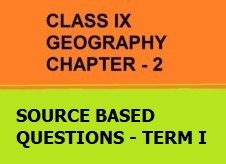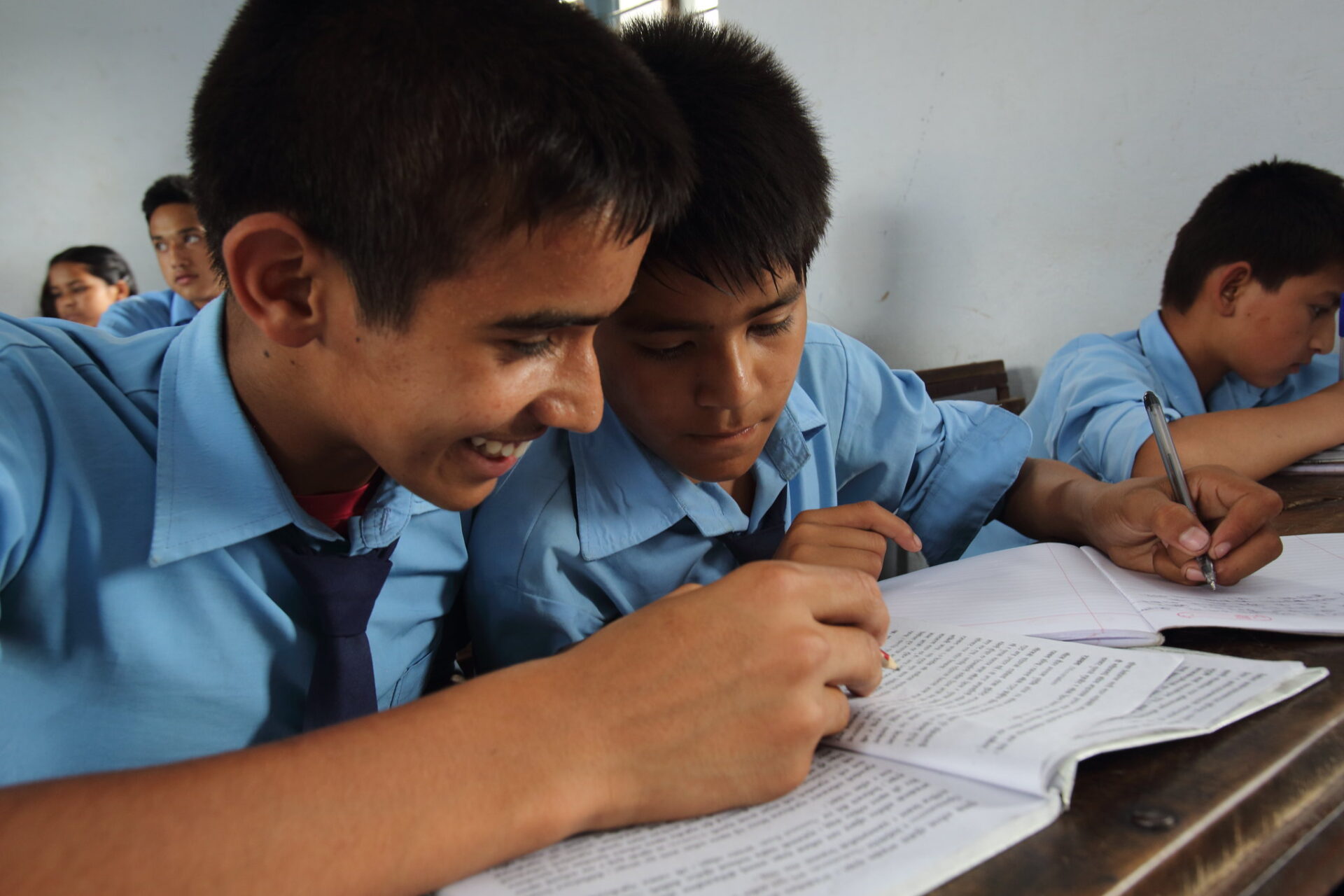Class IX – Geography Source-Based Questions From Chapter 2
Geography source-based questions are prepared for practice for class 9 students. Geography Source-based questions (SBQ) in Social Science is a new introduction in the question paper by CBSE. What is unique about these Geography 7 source-based questions? While the topic is from the textbook, the questions may not be directly from the paragraph. So, how can a student perform well if the questions are from outside the textbook? Well, a student needs to apply the following three strategies to attempt Geography source-based questions (SBQ). They are:
Firstly, Read the chapter line by line.
Secondly, Develop an understanding of the topic.
Thirdly, Practice a lot to master source-based questions.

1. India is a vast country with varied landforms. What kind of terrain do you live in? If you live in the plains, you are familiar with the vast stretches of plain land. In contrast, if you live in a hilly region, the rugged terrain with mountains and valleys are common features. In fact, our country has practically all major physical features of the earth, i.e., mountains, plains, deserts, plateaus, and islands. Therefore, the land of India displays great physical variation. Moreover, the Peninsular Plateau constitutes one of the ancient landmasses on the earth’s surface. Whereas, the Himalayas and the Northern Plains are the most recent landforms.
The whole mountain system of the Himalayas represents a very youthful topography with high peaks, deep valleys, and fast-flowing rivers. Therefore, the northern plains are made of alluvial deposits. However, the peninsular plateau is made of igneous and metamorphic rocks (Courtesy – NCERT textbook)
Read the paragraph carefully and answer the following questions:
I) Name the most stable and the most unstable zone of India. 1.
Ans. The Peninsular plateau is the most stable zone of India.
The Himalayan mountains is the most unstable zone of India.
II) How can you say that the Himalayas represents a very youthful topography? 1.
Ans. The Himalayas have high peaks, deep valleys, and fast-flowing rivers. Thus, it proves that the Himalayas represents a very youthful topography.
iii) Geologically, name the most ancient and the most recent landforms of India. 2.
Ans. The peninsular plateau is the most ancient landform in India.
Whereas the Himalayas and the Northern plains are the most recent landforms of India.
2. Today, the Himalayas mountain ranges run in a west-east direction. The Himalayas represent the loftiest mountain barriers in the world. Moreover, their width varies from 400 Km in Kashmir to 150 Km in Arunachal Pradesh. Therefore, the altitudinal variations are greater in the eastern half. Basically, the Himalayas consists of three parallel ranges.
Firstly, the northernmost range is known as the Great or Inner Himalayas or the Himadri. Secondly, the range lying to the south of the Himadri is known as Himachal. Moreover, the range is mainly composed of highly compressed and altered rocks. Thirdly, the outermost range of the Himalayas is called the Shiwaliks. However, this range is made of loose sediments. (Courtesy – NCERT textbook)
Disaster Management Project for Class 9 – Complete Guide
Read the paragraph carefully and answer the following questions:
I) Identify the most continuous range consisting of the loftiest peaks? 1.
Ans) Himadri also known as the Greater Himalayas is the most continuous range consisting of the loftiest peaks.
II) Why is the Himachal range highly compressed? 1.
Ans) Firstly, the Himachal range lies between Himadri and Shiwaliks
Secondly, as this range lies between two prominent ranges, therefore it gets compressed.
iii) What are Himachal and Shivalik ranges known for? Why are Shivaliks prone to earthquakes? 2.
Ans) Himachal range is known for beautiful hill stations like Kullu, Manali, Mussoorie, etc. whereas the Shiwalik range is known for dense forests. Moreover, the Shivalik is also a source of herbal medicinal plants.
Shivaliks are prone to earthquakes because they are composed of unconsolidated sediments.
हिमालय-भारत का सबसे कमज़ोर पर्वत
3. Besides the latitudinal divisions, the Himalayas also have four divisions from west to east. However, these divisions are demarcated by river valleys. For example, the part of the Himalayas lying between Indus and Satluj is traditionally known as Punjab Himalaya. But it is also known regionally as Kashmir and Himachal Himalaya respectively. The part of the Himalayas lying between the Satluj and Kali rivers is known as Kumaon Himalayas. Further, the Kali and Teesta rivers demarcate the Nepal Himalayas. Finally, the part lying between Teesta and Dihang rivers is known as Assam Himalayas.
The Brahmaputra marks the easternmost boundary of the Himalayas. Further, the Himalayas bends sharply to the south and spread along the eastern boundary of India. They are known as the Purvachal. (Courtesy – NCERT textbook)
Read the paragraph carefully and answer the following questions:
CLASS IX TERM I MAP WORK FROM GEOGRAPHY SOLVED AS PER THE LATEST SYLLABUS
I) On what basis do the Himalayas are divided from the west to the east? 1.
Ans. The divisions have been demarcated by river valleys.
II) Between which two rivers lie the Assam Himalayas? 1.
Ans. Assam Himalayas lie between the Teesta and Dihang rivers.
iii) What do you know about Purvanchal? Which hills together comprise Purvanchal? 2
Ans. The Himalayas bend sharply to the south and spread along the eastern boundary of India. They are known as the Purvachal. These hills running through the northeastern states are mostly composed of strong sandstones which are sedimentary rocks.
The Purvachal comprises of the Patkai hills, the Naga hills, the Manipur hills, and the Mizo hills

4. The northern plain has been formed by the interplay of the three major river systems, The deposition of alluvium in a vast basin lying at the foothills of the Himalayas over millions of years, formed this fertile plain The plain is a densely populated physiographic division. With a rich soil cover combined with an adequate water supply and favorable climate. The Northern Plain is broadly divided into three sections. The Indus and its tributaries — the Jhelum, the Chenab, the Ravi, the Beas, and the Satluj originate in the Himalayas.
The Ganga plain extends between the Ghaggar and Teesta rivers. It is spread over North India in Haryana, Delhi, U.P., Bihar, partly Jharkhand, and West Bengal. In the East, particularly in Assam lies the Brahmaputra plain. However, the northern plains are generally described as flat land with no variations in its relief. It is not true. (Courtesy – NCERT textbook)
Read the paragraph carefully and answer the following questions:
i. Name the three major river systems responsible for the formation of the Northern Plains of India. 1.
Ans. The three major river systems responsible for the formation of the Northern Plains of India are the Indus, the Ganga, the Brahmaputra, along with their tributaries.
II) What do you mean by “Doab”? 1.
Ans. The land between two rivers is referred to as “Doab”.
iii) Why are the Northern plains densely populated? Give two reasons. 2.
Ans. The Northern Plains are densely populated because of
a) Firstly, rich soil cover.
b) Secondly, adequate water supply and favorable climate.
5. According to the variations in relief features, the Northern plains have four regions. The rivers, after descending from the mountains deposit pebbles in a narrow belt of about 8 to 16 km in width lying parallel to the slopes of the Shivalik. It is known as bhabar. Further,South of this belt, the streams and rivers re-emerge and create a wet, swampy, and marshy region known as terai. However, the forests have been cut to create agricultural land and to settle migrants from Pakistan after the partition.
The largest part of the northern plain is made up of older alluvium. Moreover, It lies above the flood plains of the rivers and presents a terrace-like feature. This part is known as bhangar. But, the soil in this region contains calcareous deposits, locally known as kankar. The newer, younger deposits of the floodplains are the khadar. As they are renewed almost every year, so they are fertile. Thus, ideal for intensive agriculture. (Courtesy – NCERT textbook)
Read the paragraph carefully and answer the following questions:
I) Define Bhabhar. 1.
Ans. The rivers, after descending from the mountains deposit pebbles in a narrow belt of about 8 to 16 km in width lying parallel to the slopes of the Shivalik. It is known as bhabar.
II) Name the four divisions of the Northern plains. 1.
Ans. First, the four regions of the Northern plains are:
a) Bhabhar b) Tarai c) Bhangar and d) Khadar
III) Give two reasons as to why the forests are cut in the Northern Plains? 2.
Ans. Two reasons for the depletion of forest cover in the Northern Plains are:
a) Firstly, the forests are cut to create agricultural land, and
b) Secondly, to settle migrants from Pakistan after the partition.
6. The Peninsular plateau is a tableland made from old crystalline, igneous and metamorphic rocks. It was formed due to the breaking and drifting of the Gondwana land and thus, making it a part of the oldest landmass. This plateau consists of two broad divisions, namely, the Central Highlands and the Deccan Plateau.
To the south of the Vindhyan range is the Satpura range. The Aravalis lie in the northwest. However, the further westward extension gradually merges with the sandy and rocky desert of Rajasthan. The rivers that drain in this region are the Chambal, the Sind, the Betwa, and the Ken. They flow from southwest to northeast, thus indicating the slope. (Courtesy – NCERT textbook)
Read the paragraph carefully and answer the following questions:
I. How was the Peninsular plateau formed? 1.
Ans. The peninsular plateau was formed due to the breaking and drifting of the Gondwanaland.
II. Name the two broad divisions of the peninsular plateau. 1.
Ans. The two broad divisions in which the peninsular plateau can be divided are:
a) Central highlands and
b) Deccan plateau.
III) Mention the names of the plateaus that form the Central Highlands? The Chambal, the Sind, the Betwa, and the Ken are the tributaries of which river? 2.
Ans. Vindhya Range, Satpura range, Aravali hills, and the Chota Nagpur plateau together form the Central Highlands.
The Chambal, the Sind, the Betwa, and the Ken are the tributaries of the river Ganga.
7. The Peninsular plateau has a stretch of narrow coastal strips, running along the Arabian Sea on the west and the Bay of Bengal on the east. The western coast lies between the Western Ghats and the Arabian Sea and is a narrow plain. It has three sections. The plains along the Bay of Bengal are wide and level. Large rivers, such as the Mahanadi, the Godavari, the Krishna, and the Kaveri form an extensive delta on this coast. Lake Chilika is an important feature along the eastern coast.
You know that India has a vast mainland. Besides this, the country has two groups of islands. The Lakshadweep and the Andaman and Nicobar islands. (Courtesy – NCERT textbook)
Read the paragraph carefully and answer the following questions:
I. Name the two sections (divisions) of the eastern coastal plains? 1.
Ans. The two divisions of the eastern coastal plains are
a) Firstly, The Northern Circars and
b) Secondly, The Coromandal coast.
II. What is the capital of Lakshadweep? What are these islands known for? 1.
Ans. The capital of Lakshadweep is Kavaratti. These islands are known for corals.
III. Why is the western coastal plains narrower than the eastern coastal plains? 2.
Ans. Firstly, western coastal plains are narrow because none of the rivers flowing westward does the depositional work.
Whereas, east flowing rivers like Mahanadi, Godawari, Krishna, and Kaveri do depositional work and form the delta.
Therefore, the western coastal plains are narrower than the eastern coastal plains.
Conclusion: Geography Source-Based Questions From Physical Features Of India
To be more precise, Geography source-based questions are not very easy to answer. So, You need to practice a lot to answer Geography source-based questions. Moreover, Physical Features Of India is a small chapter but it has many concepts of Geography. Therefore, many types of Geography source-based questions can be asked.
So, solve all the above Geography source-based questions before going to the examination hall. I Hope, these Geography source-based questions will increase your understanding. Finally, It will also help you to easily attempt Geography source-based questions. For source-based questions from India – size and Location, click on the link.
Class IX Geography Chapter-2 Physical Features Of India Lesson Plan





0 Comments